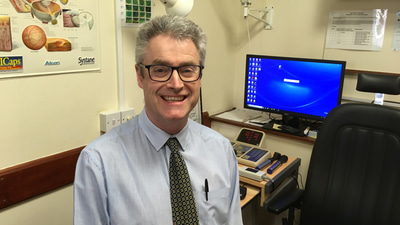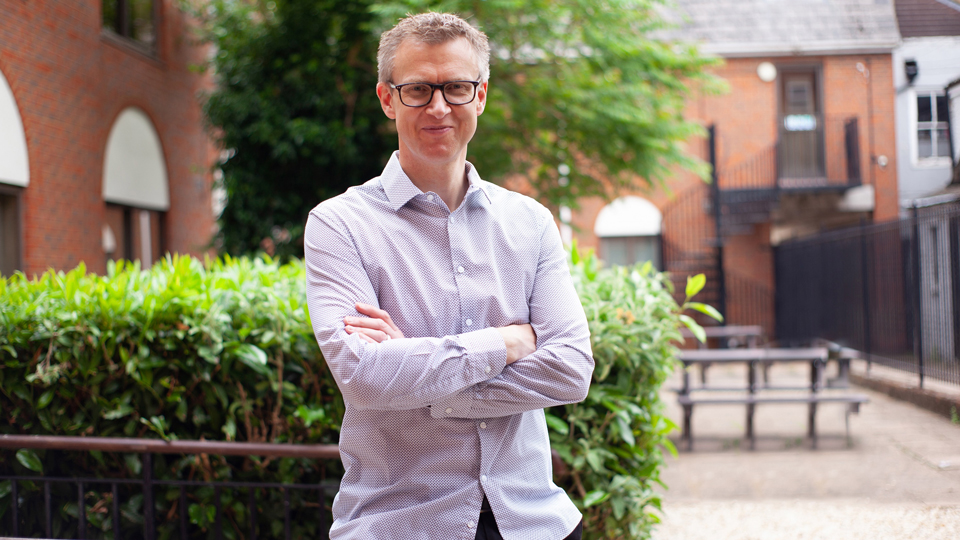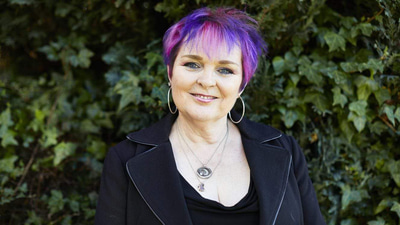- OT
- Life in practice
- Practitioner stories
- Ensuring safety for domiciliary staff post-pandemic
The discussion
Ensuring safety for domiciliary staff post-pandemic
The face of domiciliary optometry has changed over the past two years – but what changes are here to stay, and how has the sector changed for the long-term? OT investigated

14 March 2022
The care of vulnerable patients has had an extra layer of complexity in recent times, and with COVID-19 still at the forefront of healthcare professionals’ minds it looks unlikely that this situation will change any time soon.
OT asked three domiciliary care providers how they’re mitigating risk, and what staff in this part of the sector should expect their days to look like in the long-term.
Domiciliary challenges
The panel
- Dawn Roberts, clinical director at Specsavers Home Visits
- Nick Wingate, director of professional services at OutsideClinic
- Derek Michael, optometrist and director at Hakim Group independent practice James Kidner Opticians.
The landscape over the past two years, she says, “is very different in some ways and yet unchanged in others. We have always taken infection control seriously at Specsavers, and hand washing, antibacterial gel and cleaning of reusable equipment is something routine to us.”
At domiciliary provider OutsideClinic, Nick Wingate agrees: “We know that our patients fall into a vulnerable category, from a health point of view – that's why we're going to see them at home. They have a variety of health conditions that we have always been sensitive to. We have very extensive protocols and standard operating procedures to keep our patients safe and our practitioners safe as well, through infection control policies, use of personal protective equipment (PPE.) We often exceed the guidance with regard to PPE, which keeps our practitioners and patients as safe as possible.”
Extra precautions brought about by the pandemic have and will remain a key component of domiciliary practice. “Triaging patients for symptoms, wearing PPE, and having staff take lateral flow tests is different,” Roberts said, “and is something that we think will be staying with us for the foreseeable future.”
Wingate also believes that COVID-19 practices are likely here to stay: “All our new processes have been incorporated into what we do,” he said. “When we restarted in July 2020, it was a very different situation. Colleagues hadn't tested for three or four months. And then suddenly, we were asking them to incorporate PPE and infection prevention control (IPC) processes. But now, as with optometry in any context, it's just about learning a new routine.”
He added: “Taking COVID-19 out of the equation, our patients still usually have coexisting health issues. Perhaps having enhanced infection control protocols actually is a good thing, that we should be continuing with to keep them even more safe than we were beforehand. COVID-19 has highlighted the fact that we could use these processes just in general practice. I don't think there's anything we need to change back.”

“We've found the biggest challenge to be sufficient cleaning and social distancing in the person’s home,” he explained. “A lot of the houses are small, semi-detached homes, with small lounges where we usually test.”
Michael’s staff have also realised that a lot of patients are reluctant to wear masks in their own homes, and he has also noticed that some care homes are no longer requiring that optometrists take a lateral flow before attending to perform eye examinations. It is up to the practice itself, he said, to ensure that staff return negative tests before visiting vulnerable patients.
Taking COVID-19 out of the equation, our patients still usually have coexisting health issues. Perhaps having enhanced infection control protocols actually is a good thing
He added: “It is imperative that all pre-COVID-19 screening is done. My main advice would be to ensure the patient is not exhibiting symptoms the day before the visit, and that it is just them in the room that is being used for the eye examination.”
He advised that optometrists should “politely ask the patient’s partner or other family members to stay in another room for the duration of the test, unless someone is needed for assistance.”
Roberts takes the view that assuming all patients are inherently vulnerable is the safest option. “We treat all of our patients in the same way,” she said. “Masks, gloves, aprons and visors are worn routinely, and stringent IPC measures and triaging all help to protect them and us.”
An increased demand
At OutsideClinic, Wingate saw an inevitable upswing in demand after the first lockdown ended in the summer of 2020 – something that hasn’t abated in the almost two years since. Whilst positive for business, the challenge for OutsideClinic quickly became the swift recruitment of new staff, many of whom had come from High Street optometry and hadn’t worked in a domiciliary setting before. Making sure they could adapt safely to a domiciliary setting was key.

“We needed to upscale the number of optometrists that we employed quite quickly, which is why over the last 18 months or so we've had a massive recruitment drive to improve the number of optometrists who work for us to try and keep up with the demand,” he explained. “We understand that doing a different role in the same sector can be a challenge, and we need to make that transition from the High Street store into domiciliary as smooth as possible and give our colleagues whatever help they need in order to make it successful.”
Success for OutsideClinic means keeping the patient at the centre, and after an interview process and two or three onboarding days at the company’s Swindon head office, new recruits are gradually introduced into the field – albeit with a high level of support.
Wingate said: “Once they've done those two or three days with us in the office in Swindon, they will go back home, and we will gradually introduce a number of patients for them to see, normally one or two on the first day and then another one on the next day, and then we gradually build up. They're accompanied at those appointments, in that initial phase of their time with us.”
An initial challenge, he added, is not a safety one, but rather one of logistics: “The biggest issue that colleagues have is usually that their equipment isn't in the same place every single time they do a test, because somebody's sofa, where you put all your equipment, is on one side for one patient and a different side for another patient. We're quite routine people, and therefore having things that are outside our routine can be a little bit off-putting.
“That's where we need to get colleagues comfortable in understanding the flexibility around providing the optometric parts of the service. We're here to give them help and advice on how they might over time gradually morph their High Street optometric routine into a domiciliary optometric routine, which by and large is identical, but with some subtle differences.”
Conflict resolution
How have optometrists handled situations where a patient has become agitated whilst an eye examination is taking place?
Roberts pointed out that, particularly for domiciliary optometrists, this situation is not unique to COVID-19.

She added: “We take guidance from carers and relatives if the patient does not have the capacity to make a decision, and the MCA says that those decisions must be shown to be in the patient’s best interests.”
Wingate emphasises that following the patient’s lead, and following up afterwards if needed, is vital.
“Consent and patient safety go very much hand in hand,” he said. “We must keep the patient safe, and they need to absolutely consent to what service we're going to provide for them.
“If they change their mind, then that's absolutely fine. We will hopefully have been able to demonstrate that we are keeping their health and safety at the heart of what we're doing. But people can be nervous and the situation may come to a point where they decide that they don't want to be seen anymore. Our optometrists are given help and guidance on how to deal with that, to make sure they tidy up appropriately and exit the appointment. We then follow up from head office and see whether the patient would like to rebook, and whether an advocate or next of kin can be present, to give them some support next time.”
There's no point us being blasé, because then we're going to compartmentalise a group of patients who are still very nervous, and we don't want them to feel nervous
He added: “Every patient that we book, we always ask if they want somebody to accompany them. A lot of our patients are fiercely independent, and that's fantastic. Others do like to be supported, and then we would go through our normal booking process to make sure we can contact the advocate or that the advocate at least knows when we're going to be going. Some patients are very independent and that's brilliant, but sometimes, it might just be a bit too much for them.”
Michael is keen to emphasise that the day-to-day work of domiciliary optometry has remained fulfilling throughout the pandemic, with patients being largely receptive, and that he expects this to continue. “Most patients have been fine having their eyes tested,” he said, “and actually find our visit the high point of their day or week – particularly if they have few visitors.”
Mixed messages
“We have found it really quite difficult to keep up with the constant changes of policy from central Government,” Wingate explained. “We have a standard operating procedure that all our optometrists are signed up to, and to change that policy might sound quite an easy task, but it isn't. When the policies from central Government change so quickly, you're almost playing catch up every week.”
He added: “We will always follow the College guidance. That can be somewhat different to the headlines on BBC News, because healthcare workers are treated somewhat differently to the rest of the general population, because obviously we are dealing with patients who are vulnerable. Sometimes a colleague will see what the news says, but that's not actually what the College guidance or the UK Health Security Agency guidance is.
“My job has become a bit more difficult, in the fact that you're trying to convince colleagues that yes, you can listen to Boris, but you do also need to listen to your professional body. This is what we're going to be judged against. If something goes wrong, we're going to be judged against those guidelines and the overarching health care guidelines, which are different to that main headlines. From an OutsideClinic point of view, we are always going to err on the side of caution.”
The future
Looking ahead to a hopefully COVID-19-free future, do the panel foresee any major changes to the way that domiciliary optometrists work in the longer term?
Roberts believes so: “I think the legacy of the pandemic will be a permanent heightened awareness of infection prevention and control,” she said. “I suspect we will always wear masks now; in fact, I wonder why optometrists didn’t do so before.”
For Wingate, the immediate future is all about stratifying risk. “We're very used to wearing masks and gloves and making sure all our equipment is clean,” he said. “We try and do a lot of our history and symptoms on the phone remotely, before we see the patient, to try and reduce the face-to-face contact time. We ask the patient to have the windows open when we arrive, which can be a little bit tricky when it's absolutely freezing outside – you don't really want an elderly person in the cold. It's all about risk assessment: stratifying that risk, and keeping the risk as low as possible.”
There’s always a balance to be found, he believes: “The easiest way of having a zero risk is not to provide service at all, but that's not good for the patient. We need to look after their eye health and their visual demands and requirements. So, we have to keep the risk as low as possible. They've just extended the free PPE for another 12 months. I think that says a lot – if central Government are going to pay for PPE for optometric practices for another year, we should really be using it.”
What has always been our philosophy, and would be my advice with or without COVID-19, is to treat the patient in the way you would want your own parents or grandparents to be treated
Safety comes from a base level that protects everyone, Wingate explained: “When you look at our patient base, we have a massive range of different outlooks. Some patients are very relaxed about COVID-19 now. They've probably been triple jabbed, they don't see many people, and therefore their risk is quite low and they're quite relaxed about it. We have other people with more serious health conditions, who are still very nervous about it, who deliberately haven't seen anybody for two years, and they're still very frightened. We need to provide a service appreciating that level of concern, and then we'll cover everybody else. There's no point us being blasé, because then we're going to compartmentalise a group of patients who are still very nervous, and we don't want them to feel nervous. We want them to feel confident that we have their best interests and their health at the centre of what we do.”
Given the length of the pandemic, some optometrists may have only worked in the context of PPE, extra cleaning, and periods of social distancing. What advice would be most helpful to ensure their continued safety in a post-COVID-19 world?
“We will be living with COVID-19 in one form or another for a very long time, so this is our new normal,” Roberts says. “We have made the changes we needed to, and they are embedded in our daily lives.
“What has always been our philosophy, and would be my advice with or without COVID-19, is to treat the patient in the way you would want your own parents or grandparents to be treated.”
Advertisement


Comments (0)
You must be logged in to join the discussion. Log in